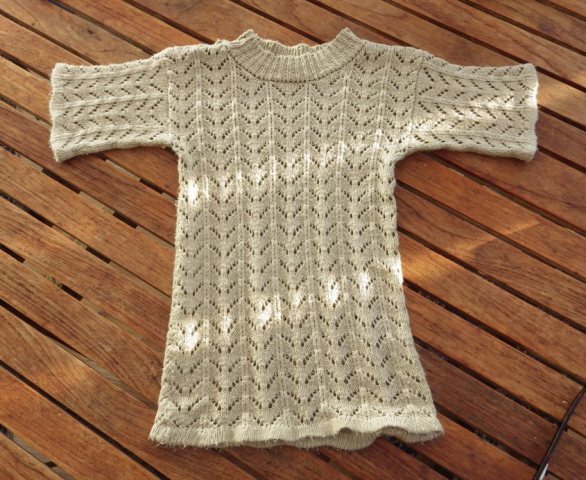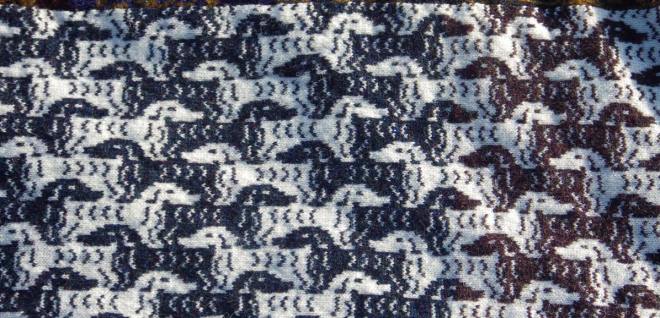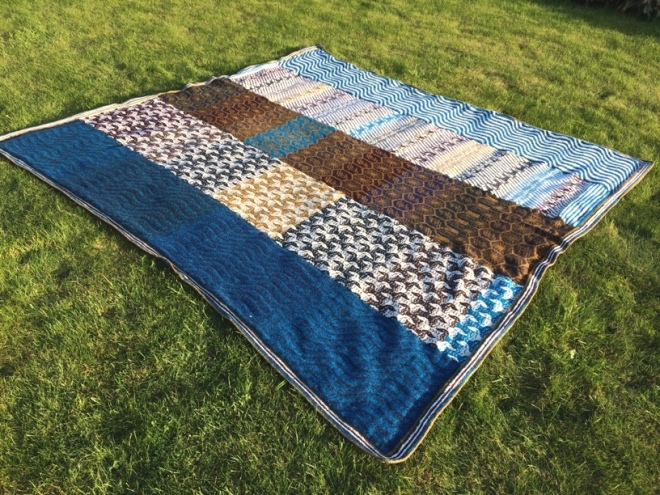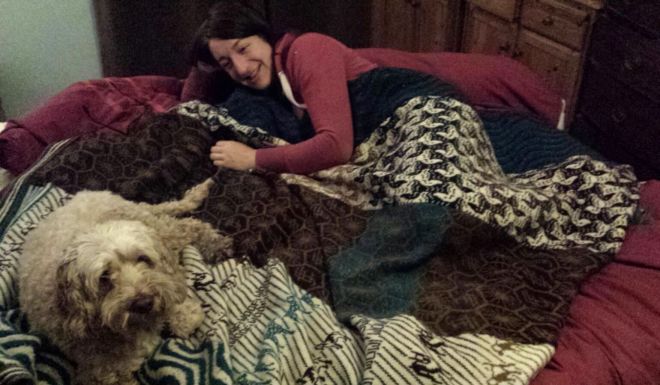Guest Editor Stephen:
I was in my early thirties when I first got interested in machine knitting, and having obtained a machine, used it to knit garments mainly for my two youngest daughters. The only garment left from this time is this child’s lace top knitted in cotton:
 When, we moved to Devon about 5 years after I had knitted this, I continued to use the machine, but focused on knitting whole panels which were sewn up into blankets. I am more interested in the patterning possibilities of the machine than constructing garments.
When, we moved to Devon about 5 years after I had knitted this, I continued to use the machine, but focused on knitting whole panels which were sewn up into blankets. I am more interested in the patterning possibilities of the machine than constructing garments.
Here are two blankets from that time that we still use on our bed:
 The left-hand one is all my own work; the other was put together by Katherine from her hand-knitted and my machine-knitted samples and test swatches. When we tried to put this blanket on display at a craft show in Devon there was much debate about whether it should be included as some on the selection committee did not consider my pieces ‘craft’! Eventually it was displayed, thrown over a beam high up at the back of the room.
The left-hand one is all my own work; the other was put together by Katherine from her hand-knitted and my machine-knitted samples and test swatches. When we tried to put this blanket on display at a craft show in Devon there was much debate about whether it should be included as some on the selection committee did not consider my pieces ‘craft’! Eventually it was displayed, thrown over a beam high up at the back of the room.
I also knitted a blanket in black and white for my stepson. It recently returned to us for repair and washing when he moved house.
 These 3 panels show off some of the inspirational ideas I use for my design.
These 3 panels show off some of the inspirational ideas I use for my design.
The top one is mathematically based on Sine Curves with alternating wavelengths. The all-black portions are where the waves overlap.
The middle one is based on stitches whose colour is chosen at random. The chances of a stitch being black gradually changes from 11/12 at the left to 1/12 on the right.
The bottom one is influenced by Op Art, in particular the work of the British artist Bridget Riley.
This photo is from the time I made this blanket and shows my holding the punchcard for the sine curves. Like all punchcards for this machine it has a width of 24 stitches, but can be as long as you like. The ends are clipped together and so it operates as a continuous loop. In September last year my daughter Ellie got married in Cornwall – and asked me if I could knit her a new blanket. There’s a challenge – but happy to oblige for this late wedding present. The themes I thought I would use were the sea and dogs – she and her husband Jak have a dog called Bailey who is somewhat spoiled.
In September last year my daughter Ellie got married in Cornwall – and asked me if I could knit her a new blanket. There’s a challenge – but happy to oblige for this late wedding present. The themes I thought I would use were the sea and dogs – she and her husband Jak have a dog called Bailey who is somewhat spoiled.
Here are some of our collection of cones of wool, including some monofilament glitter to add to the mix, from which K put together a palette of colours for the blanket. The machine will knit fair isle – ie two colours in one row. And I got designing –
 – and setting up the knitting machine. It is a similar model to the one I had all those years ago. When we moved to Northumberland 6 years ago I got rid of all my old equipment, but have since been re-acquiring it.
– and setting up the knitting machine. It is a similar model to the one I had all those years ago. When we moved to Northumberland 6 years ago I got rid of all my old equipment, but have since been re-acquiring it.
Just as Cornwall is bounded on the east and west by the sea, so my blanket is framed by patterns based on waves. Each wave pattern uses Sine Curves such as this which are stacked up, and given a sideways shift.
Sine curve
Here is the punchcard for this design:
 which gives this when knitted up:
which gives this when knitted up:
 Indeed, it gives an optical illusion when viewed from a certain angle, that the fabric is not flat but undulating:
Indeed, it gives an optical illusion when viewed from a certain angle, that the fabric is not flat but undulating: The second wave design is similar, but the stitches between the wave forms have been chosen at random, gradually tailing off until the next wave to given a broken effect, almost like breaking waves.
The second wave design is similar, but the stitches between the wave forms have been chosen at random, gradually tailing off until the next wave to given a broken effect, almost like breaking waves. In addition I broke up the pattern by having a completely random section across the panel after every third complete sine wave. That occurs at either end of this pattern’s punchcard:
In addition I broke up the pattern by having a completely random section across the panel after every third complete sine wave. That occurs at either end of this pattern’s punchcard:
 Again, from the right angle, the fabric no longer appears flat:
Again, from the right angle, the fabric no longer appears flat:
 And so to dogs! This was a real labour of love as I have no great fondness for dogs and find it very difficult to be in a room with a dog. But I put together two dog-themed panels to go next to the waves.
And so to dogs! This was a real labour of love as I have no great fondness for dogs and find it very difficult to be in a room with a dog. But I put together two dog-themed panels to go next to the waves.
The first used 4 different dog motifs from a book by Wendy Phillips, along with some doggy words: I alternated each pair of dogs with one of the word motifs. I also had a common background, white, for the whole panel, and added the diagonal stripes to tie it all together.
I alternated each pair of dogs with one of the word motifs. I also had a common background, white, for the whole panel, and added the diagonal stripes to tie it all together. I particularly like the Dalmatian design. Notice how I have had to put the letters of the words stepping down so that I didn’t have a single float for the row underneath the words across the whole panel.
I particularly like the Dalmatian design. Notice how I have had to put the letters of the words stepping down so that I didn’t have a single float for the row underneath the words across the whole panel.
The other dog-themed panel is based on a print by one of my favourite artists, MC Escher: This design has always fascinated me as to how it works with its tessellating dogs pointing in two different directions. It took me a long time, and many failed attempts, until I came up with this punchcard:
This design has always fascinated me as to how it works with its tessellating dogs pointing in two different directions. It took me a long time, and many failed attempts, until I came up with this punchcard:
 And this is what results when it is knitted:
And this is what results when it is knitted: The central panel is specially for my daughter and her husband with a motif of their initials, J & E, intertwined. I placed this in tessellating hexagons, alternating with a star motif.
The central panel is specially for my daughter and her husband with a motif of their initials, J & E, intertwined. I placed this in tessellating hexagons, alternating with a star motif. This is the punchcard I created:
This is the punchcard I created: You can see the initials quite clearly. You may notice that the hexagons on the punchcard are somewhat elongated. This is because, when designing patterns for the machine, you have to take into account the fact that each row is roughly half as high as the width of a stitch – ie to knit a square with a width of 100 stitches, you would have to knit 200 rows. An added complication.
You can see the initials quite clearly. You may notice that the hexagons on the punchcard are somewhat elongated. This is because, when designing patterns for the machine, you have to take into account the fact that each row is roughly half as high as the width of a stitch – ie to knit a square with a width of 100 stitches, you would have to knit 200 rows. An added complication.
Here is part of the end result: What’s gone wrong here? In fact the punchcard snagged on the edge of the machine and jammed for about 16 rows until I noticed – hence the elongated legs on the star!
What’s gone wrong here? In fact the punchcard snagged on the edge of the machine and jammed for about 16 rows until I noticed – hence the elongated legs on the star!
Now, with all five panels knitted, in total about 560,000 stitches, that is 5 panels of 140 stitches, each with 800 rows, they could be sewn up. Katherine did the bulk of this but I did one of the them: But our cats, Eggy and Ilsa, sometimes were not very helpful:
But our cats, Eggy and Ilsa, sometimes were not very helpful: But we managed, and then Katherine crocheted all around the edge several times to give a weighty edge to the blanket and to tie all the colours together. I have tried to do this, but somehow I just cannot master this task that she makes look so easy:
But we managed, and then Katherine crocheted all around the edge several times to give a weighty edge to the blanket and to tie all the colours together. I have tried to do this, but somehow I just cannot master this task that she makes look so easy: Again, the cats thought they had a found a wonderfully warm place to sleep – and things ground to a halt:
Again, the cats thought they had a found a wonderfully warm place to sleep – and things ground to a halt: But eventually all was completed. Then Katherine very lightly washed the blanket using a machine wool wash to get any wax or oil out of the wools, and we hung it outside to dry:
But eventually all was completed. Then Katherine very lightly washed the blanket using a machine wool wash to get any wax or oil out of the wools, and we hung it outside to dry: Here it is laid out on the lawn. You can clearly see all the designs, and Katherine’s crocheted edge tying it all together:
Here it is laid out on the lawn. You can clearly see all the designs, and Katherine’s crocheted edge tying it all together: And so we sent it off to Cornwall to the happily married couple, about 13 months after their wedding. Here is one happy recipient along with Bailey – Enjoy this blanket made for you all with love:
And so we sent it off to Cornwall to the happily married couple, about 13 months after their wedding. Here is one happy recipient along with Bailey – Enjoy this blanket made for you all with love:
The technical stuff:
In case you are wondering how I construct my designs here is a brief explanation:
Once I have worked out my design, I write a computer program to convert it into the stich pattern I need. I do this using a program called BASIC, which I first learnt over 35 years ago. I use a freeware version of this program called Just Basic or JBASIC, which you can download at: http://www.justbasic.com
At present I am working on a Christmas-themed design called Blizzard. It consists of overlayered snowflakes, the size, orientation and position of each snowflake being chosen at random. Here is the program I wrote: When I run this, it generates possible patterns to use. When I find one that is particularly interesting I can then print it out. It comes out like this, 24 stitches wide and repeating every 108 rows:
When I run this, it generates possible patterns to use. When I find one that is particularly interesting I can then print it out. It comes out like this, 24 stitches wide and repeating every 108 rows: This is then transcribed onto a piece of punchcard cut from a long roll, and punched out to give the following:
This is then transcribed onto a piece of punchcard cut from a long roll, and punched out to give the following:
 But what will the resulting knitted pattern look like? Watch this space!
But what will the resulting knitted pattern look like? Watch this space!

A wonderful body of work Stephen. The maths left me behind fairly quickly, but the work is beautiful. Love the little dog especially.
LikeLike
Thanks for your kind words Mandy. As you know dogs are not my thing but Elly and Jak are thrilled with their dog-themed blanket. Did you know I did machine knitting when we were in Crediton?
LikeLike
Impossibly clever and brilliant, Stephen! Lucky daughter.
LikeLike
Thank you for your comment Polly. Having the time to explore ones ideas and see them to fruition is one of the brilliant things about being retired.
LikeLike
My word, the blanket you have created is truly lovely. Such care and thought in its construction and pattern a very lovely and extraordinary gift!
LikeLike
Thank you for your kind words Lydia. Luckily I have the time in retirement to pursue my interests.
LikeLike
wow! What a beautiful blanket and with such care and love put into it from both of you! She is a very lucky daughter and you are both truly creative!
Gillyxx
LikeLike
Thank you for your kind words Gilly. Luckily K & I both have the time in retirement to pursue our interests.
LikeLike
How can they not consider it a craft with all that work in it most of them would use their brain less following a pattern beautiful work I never figured out the knitting machine one day maybe I will have time to work it out
LikeLike
Yes Elizabeth – I quite agree. it is all a question of how much technology you use I suppose. But what about spinning wheels and looms – all quite technical? I think one should judge the outcome not the process.
LikeLike
You make me want to get a knitting machine… Lovely work you did, congrats! I hope your daughter enjoyed her new blanket.
LikeLike
Thank you for your encouraging words Leonor. Go for it – there are plenty of second hand machines around – lots on ebay.
LikeLiked by 1 person
My main issue was lack of space, but that might change in the near future… I might just go for a knitting machine of my own 😀
LikeLiked by 1 person
Go for it Leonor. They do in fact all fold away into quite a neat box – but I prefer to keep mine up – so tempting. If you ever come up to Berwick upon Tweed I have an old Brother 830 you can have for free.
LikeLiked by 1 person
Oh thanks! That’s very nice of you. So sorry for the late reply, my app has stopped sending me notifications for some reason
Happy New Year!
LikeLike
Katherine here, Leonor: Technology is maddening – I keep on missing out on your blog (which I really enjoy reading) because I don’t pick new posts up. You’ve never thought of adding a “Follow by email” button …… ?! Happy New Year – and happy knitting, spinning and making!
LikeLiked by 1 person
Maddening indeed! Do you mean my new blog? I do have a button of sorts, but it’s not as straightforward as with my WP one… like you said, technology! 😩
LikeLike
Really cool blanket, must have kept you warm whilst you were stitching it together!
LikeLike
Thank you for your kind words. Perhaps we should have kept it here as Northumberland is quite a bit colder than the south-west. Still, we have lots of wool for our new projects.
LikeLike
Thank you for your kind words. Sure do keep you warm. All the wool is Shetland, and fair-isle patterns to boot so each row has two strands of wool. Mind you it is very heavy on your lap when sewing it up.
LikeLike
[J] Thanks for this, Stephen – it’s very interesting. I suspect that it took some while to learn to project reliably the final appearance based on nothing more than a screen display or paper print of the output data lines. I’m incredibly impressed by your recreation of the Escher dogs. In fact I think your dogs (they look a bit like Daschunds) are better defined and more realistic.
LikeLike
Thank you for your kind words. I am also particularly pleased with the Escher dogs. They have come out rather longer than I had anticipated but it is a bit difficult to get the tension (which controls the stitch size) right when you are mixing up yarns of different weights. But overall an intriguing design. Please feel free to copy.
LikeLiked by 1 person
Thank you for your kind words. Yes – I am very proud of how the Escher dogs turned out. Please feel free to use the pattern if you wish.
LikeLiked by 1 person
Dear Stephen, thank you SO much for this machine knitting tour!!!! I am so impressed, my favorite project is your dog blanket – so amazing! I wish I had more time to devote to my LK-150 and I dream of moving to more “grown-up” knitting machine 🙂 So much to learn, so many possibilities!!!
LikeLike
Thank you for your kind words Elina. Get a grown-up machine. They are great fun, and there are a lot available on ebay. I picked up my first one when I recently started machine knitting again on Freecycle – didn’t cost a penny. or ask around at local charity shops. They regularly get given them and find them hard to deal with. Leave them a card with your details and see what comes up. You could very well pick one up locally for a song.
LikeLike
Great to see more detail of your work Stephen. A beautiful, meaningful gift.
LikeLike
Thank you for your kind words. Have just knitted two scarves in a morino and silk yarn for my daughters for Christmas.
LikeLike
Thank you very much for lovely minuits spent on reading your blog. I started with Ellie’s Blanket and continued to read more and more with great plesure. Regards, Nadia
LikeLike
So glad you enjoyed the blog, Nadia 🙂
LikeLike